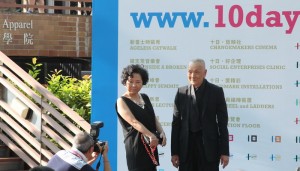Ageless design
The ageless catwalk for fashion design. The ageless housing development. The ageless solar energy installation?

The Jockey Club Design Institute for Social Innovation hosts a fashion show reworking fashion for the silver age.
It’s sometimes hard for young people and students to get inside the heads of older people. Fortunately it’s happening more often as we all try to address the needs of an aging population.
In some cases you can move something that is traditionally reserved for young or tech- savvy folks into a realm accessible by older people. At Hong Kong’s Jockey Club Design Institute for Social Innovation (part of the Hong Kong Polytechnic University) young fashion designers worked on redefining fashion for the silver set. The resulting “ageless catwalk” show featured 28 “silver age” models (up to age 89). Great expression, “silver age.”
In other cases you can consciously incorporate a wider age range. An example from Malaysia is a multi-generational apartment complex. The units make it easier fo grandparents to live with their extended families The development group includes two doctors, one of whom, Dr. Lim, commented:
“Most Asians would prefer to live with their parents and grandparents and vice versa because it gives the latter a sense of security and safety, instead of leaving it to the hands of others. That’s why we decided to develop a residential area using the concepts of multi-generational and wellness living with healthcare facilities to give residents of all age groups a comfortable and homely living environment.”
And finally, an example that is a little more tangential. A chain of retirement communities in the US state of Tennessee, Senior Solutions Management Group, has installed solar farms at several facilities that have been so successful they’re proceeding with more. The solar farms are estimated to provide about 18% of the facility’senergy needs, but this number is expected to increase as the facility also pursues measures to improve energy efficiency. Part of the “spin” on the solar farms is that they increase the overall quality of senior living, where “quality” can take on wider societal dimensions.
In order to make something ageless, we need to know about aging. How have you worked with students to improve their understanding and sensitivity to the silver age? Share you thoughts in the comments. And if you find this post usefule, pass it on to a friend and sign up in the right margin for the monthly summary (includes a bonus article).
In my teaching guide I’ve got one brief that targets this area, “Aging Beautifully,” which specifically challenges the notion of “aging in place” for affluent western societies. A few other briefs could also draw out the assets of the silver set. For example there’s a brief on designing a new “rite of passage” which could be informed by learning more about the rites of passage of our grandparents generation and why they were meaningful.
Another brief has students discovering history through memorial. This is another avenue into exploring the experiences of the sliver set to inform and contextualize how we remember.
One Response to Ageless design
Leave a reply
Subscribe
About
Join me on the first Thursday of the month for ideas, tips and inspiration for teaching and researching sutainable design. Sign up to get these posts in your inbox.



Be sure that you are taking adequate care of yourself. You want your writing to be fresh and exciting, and it is hard to think well when you are overly tired or hungry. While you are working, take breaks often to give your brain a chance to rest, and make sure that you are eating throughout the day.